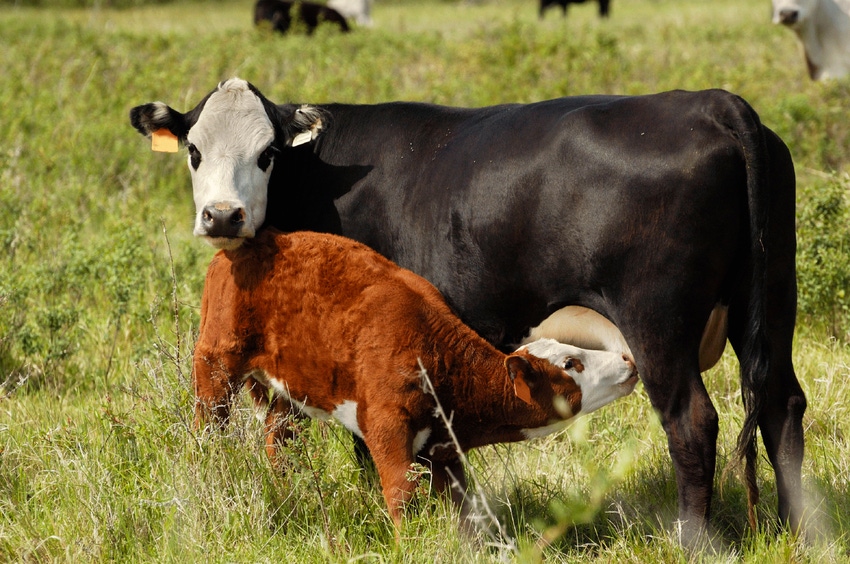The dollars and cents of crossbreeding
Why consider crossbreeding? The value of the improved productivity due to crossbreeding is worth $150 per cow per year.
February 4, 2019

By B. Lynn Gordon
With the tight margins and high input costs facing beef producers today, they are more and more focused on the return on investment (ROI) of a production practice or strategy they may implement. Impacting the bottom line positively is the primary end goal. Can crossbreeding be a production practice that will provide an increased return on investment?
“The impact of crossbreeding is the result of capturing non-additive genetic merit in one’s cowherd,” says Bob Weaber, Extension beef specialist at Kansas State University (KSU). Genetic merit is made up of both additive effects and non-additive effects.
Additive effects are those effects reflected in EPDs, breeding values and indexes. Non-additive effects are the effects from the pairing of different genes together that result in heterosis, which is a benefit of crossbreeding.
“When thinking about genetic selection, you can focus on the additive effects to make selection decisions using EPDs and indices and also get a benefit from the heterosis piece by using different types of mating systems and managing them effectively,” says Megan Rolf, assistant professor of genetics, Kansas State University.
Commercial cattlemen need to focus on both additive and non-additive effects to gain the most benefit from crossbreeding, whereas seedstock producers often put a greater emphasis on the additive genetic merit which comes from EPDs and indexes in order to market superior genetics to commercial customers.
Adding heterosis to the mix
“Heterosis has the ability to generate value for the cow-calf industry,” says Weaber. In a series of multiyear studies conducted at the Meat Animal Research Center (MARC), researchers determined the improvement in weaning weight per cow exposed, to heterosis, increased production 20-25% per cow in Bos taurus x Bos taurus crosses. Research in the subtropical regions results showed a 50% increase in percent improvement in weaning weight per cow exposed when crossing Bos indicus x Bos taurus animals.
Weaber explains when comparing various production practices, producers should use a metric that captures system-level dynamics. A metric like weaning weight per cow exposed captures a breadth of data from cow exposure through weaning, providing a view of the whole production cycle.
“Weaning weights of calves is a relatively poor indicator of production efficiency as it only focuses on the elements of what went right in our production system, rather than the true picture of the entire system or cycle. Weaning weight per cow exposed includes the failures in the production system, such as reporting of cows that didn’t conceive, death loss, etc.,” he says.
“Crossbreeding systems generate value through improvements in a number of calf and cow traits. About two-thirds of the economic value from crossbreeding comes from having crossbred cows, so if you only produce crossbred calves from straightbred cows, you miss about two-thirds of the free lunch from heterosis.”
Financial focus
Weaber and Rolf report economic advantages from the crossbred cow include increased longevity of 1.36 years over their straightbred counterparts in the same production environment, as well as nearly one calf on average more in the cow’s lifetime. The enhanced longevity and fertility yield an additional cumulative 600 pounds of weaning weight from the crossbred cow. The result is greater profitability in cow-calf production.
Digging deeper, the advantages of a crossbred calf over a straightbred counterpart also reveal the impact of heterosis. Crossbred calves have 3.2% better calving rate; have 1.4% greater survivability to weaning; a 1.7-pound increase in birth weight; a 16-pound increase in weaning weight and; a 29-pound increase in yearling weight.
In summary, a guideline is that there is a about a 4% improvement in growth rate for the individual calf and about a 4% maternal effect on weaning weight with a crossbred calf.
Impact on profit
“Crossbreeding is one of the few technologies that appears to demonstrate a return on investment though an increase on revenue and a decrease in costs,” says Weaber. The two KSU researchers report when the cowherd lasts longer, fewer replacement heifers are needed to maintain herd size, thus decreases replacement costs. This reduction in replacements provides the opportunity for more heifers to be marketed along with their steer mates to positively impact revenues.
The individual calf advantages from crossbreeding may seem limited. However, taking the improvements of reduced death loss and increased growth, the results overall can be substantial.
Using heterosis estimates from scientific literature, Weaber keeps an updated tally on the impact heterosis can have on a typical 100 head cow herd. Consider a herd with an 80% weaning rate, a 575 pound average weaning weight and over a 10-year time horizon. Then factor in the impact of weaning weight per cow exposed, a crossbred herd’s increased annual productivity is equivalent to 18 more 575-pound calves.
What does this mean to a producer’s bottom line? The value of this improved productivity due to crossbreeding in Weaber’s example is worth $150 per cow per year, using current calf prices of approximately $1.50 per pound for a 5-6 weight.
For a straightbred operation to be competitive, the straightbred calves would have to generate $198 per head more revenue to be equivalent to this crossbred herd. The straightbred herd weans fewer calves so each calf sold has to proportionally generate more income.
To make crossbreeding work for your operation, keep it simple by choosing a system that will work within your resources and managerial ability. Build a plan with attainable goals and stick to it.
Gordon is a freelance agricultural writer and regular contributor to BEEF from Sioux Falls, S.D.
You May Also Like



